A) 10.1.1.10
B) 10.1.1.12
C) 10.2.1.10
D) 10.2.1.21
Correct Answer

verified
B
Correct Answer
verified
Multiple Choice
Company 1 and Company 2 are medium-sized companies that collaborate in a joint venture. Each company owns a building, and each has their own ArubaOS 8 Mobility Master (MM) -Mobility Controller (MC) deployment. The buildings are located in front of one another. For the initial stage of the project, the companies want to interconnect their networks with fiber, and broadcast each other's SSIDs. These are the requirements: Do not unify the company's network management responsibilities. Allow each company to take care of their own SSID setups when broadcasted in the other building. Terminate Company 1 user traffic on Company 1 MCs when they connect to Company 2 APs. Terminate Company 2 user traffic on Company 2 MCs when they connect to Company 1 APs. What is needed to meet the solution requirements?
A) Multizone APs
B) Inter MC S2S Ipsec tunnels
C) Multi MC Clusters
D) Inter MC GRE tunnels
Correct Answer

verified
Correct Answer
verified
Multiple Choice
A company has headquarters based in the US and rents internation office space in Mexico City so that 10 employees can work remotely. The company must implement a remote access technology so branch office employees can access all servers at the headquareters. The office has both wired and wireless internet connectivity, with no restrictions on what device connects to the network. However, ports UDP 4500, 5060, and 5061 are blocked by the primeter firewall. Which remote access technology is required to allow employees to access the servers at the headquarters?
A) BOC with CAPs
B) IAP VPN
C) RAP
D) VIA
Correct Answer

verified
Correct Answer
verified
Multiple Choice
An organization owns a fully functional multi-controller Aruba network with a Virtual Mobility Master (VMM) in VLAN 20. They have asked a network consultant to deploy a redundant MM on a different server. The solution must offer the lowest convergence time and require no human interaction in case of failure. The servers host other virtual machines and are connected to different switches that implement ACLs to protect them. The organization grants the network consultant access to the servers only, and appoints a network administrator to assist with the deployment. What must the network administrator do so the network consultant can successfully deploy the solution? (Select three.)
A) Reserve one IP address for the second MM and another IP address for its gateway
B) Configure an ACL entry that permits IP protocol 50, UDP port 500, and multicast IP 224.0.0.18.
C) Allocate VLAN 20 to the second server, and extend it throughout the switches.
D) Reserve one IP address for the second MM and another for the VIP.
E) Configure an ACL entry that permits UDP 500, UDP 4500, and multicast IP 224.0.0.1.
F) Allocate another VLAN to the second server, and permit routing between them.
Correct Answer

verified
A,C,E
Correct Answer
verified
Multiple Choice
Refer to the exhibits. Exhibit 1 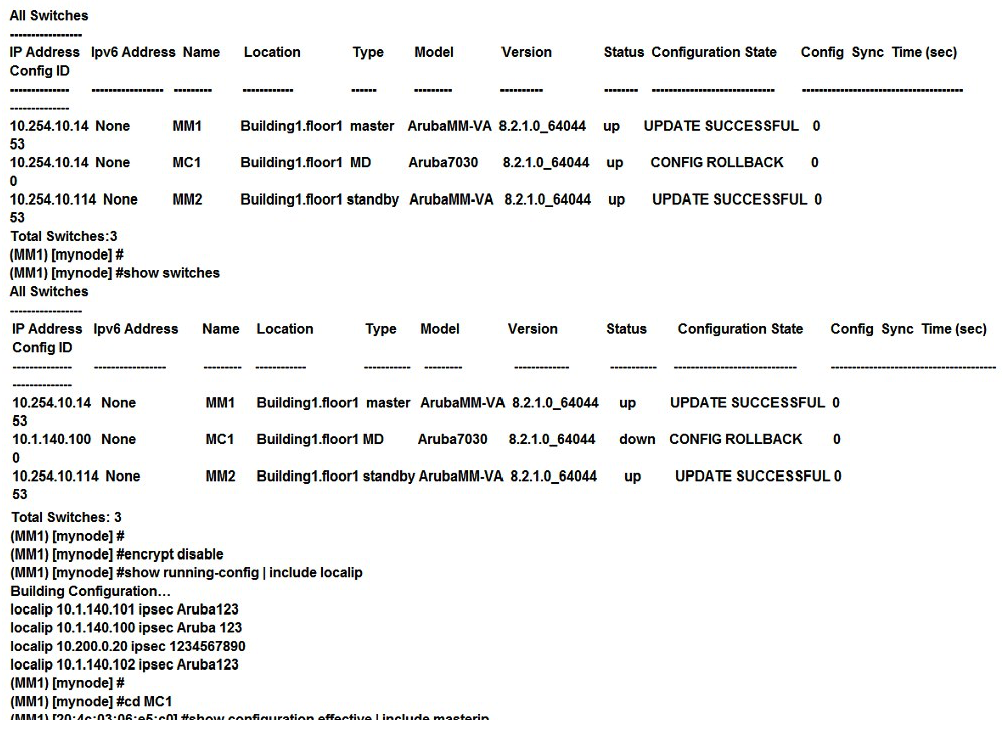 Exhibit 2
Exhibit 2  Exhibit 3
Exhibit 3 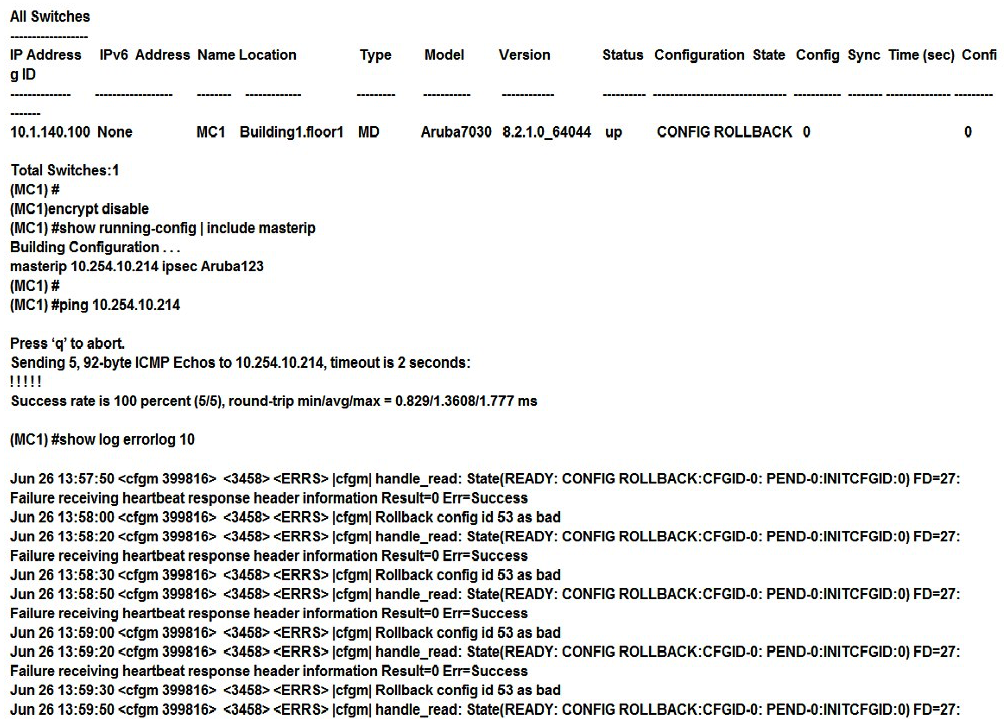 A network administrator deploys a Mobility Master (MM) pair with the VRRP VIP equal to 10.254.10.214, and attempts to associate MC1 to it. At first, the integration appears to be successful. However after a few minutes the network administrator issues the show switches command and sees that the MC1 is down, even though the device is up and running. Every time the network administrator reboots the Mobility Controller (MC) , the MC shows as being up and then it shows as being down. The network administrator gathers the information shown in the exhibits. What should the network administrator do to resolve this problem?
A network administrator deploys a Mobility Master (MM) pair with the VRRP VIP equal to 10.254.10.214, and attempts to associate MC1 to it. At first, the integration appears to be successful. However after a few minutes the network administrator issues the show switches command and sees that the MC1 is down, even though the device is up and running. Every time the network administrator reboots the Mobility Controller (MC) , the MC shows as being up and then it shows as being down. The network administrator gathers the information shown in the exhibits. What should the network administrator do to resolve this problem?
A) Change the localip ipsec key to Aruba123 in the mynode device level from the MM, save, and reboot.
B) Enable disaster recovery mode in MC1 and change the masterip ipsec key to Aruba 123, save, and reboot.
C) Change the masterip ipsec key to Aruba123 in the device level from the MM, save, then reboot MC1.
D) Wipe out the configuration in MC1 and reboot, then run the full-setup configuration dialog all over again.
Correct Answer

verified
Correct Answer
verified
Multiple Choice
Refer to the exhibits. Exhibit 1 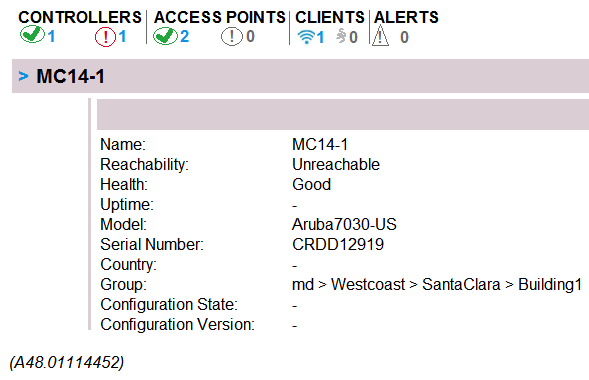 Exhibit 2
Exhibit 2 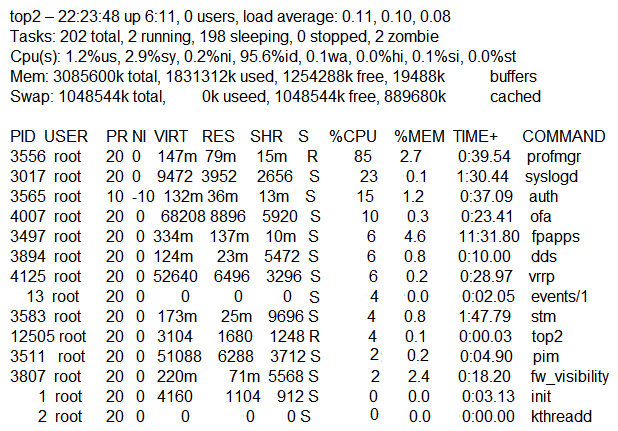 A network administrator adds a new Mobility Controller (MC) to the production Mobility Master (MM) and deploys APs that start broadcasting the employees SSID in the West wing of the building. Suddenly, the employed report client disconnects. When accessing the MM the network administrator notices that the MC is unreachable, then proceeds to access the MC's console and obtains the outputs shown in the exhibits. What should the network administrator do next to solve the current problem?
A network administrator adds a new Mobility Controller (MC) to the production Mobility Master (MM) and deploys APs that start broadcasting the employees SSID in the West wing of the building. Suddenly, the employed report client disconnects. When accessing the MM the network administrator notices that the MC is unreachable, then proceeds to access the MC's console and obtains the outputs shown in the exhibits. What should the network administrator do next to solve the current problem?
A) Decommission the MC from the MM, and add it again.
B) Open a TAC case, and send the output of tar crash.
C) Verify the license pools in the MM.
D) Kill two zombie processes, then reboot the MC.
Correct Answer

verified
Correct Answer
verified
Multiple Choice
Refer to exhibit. 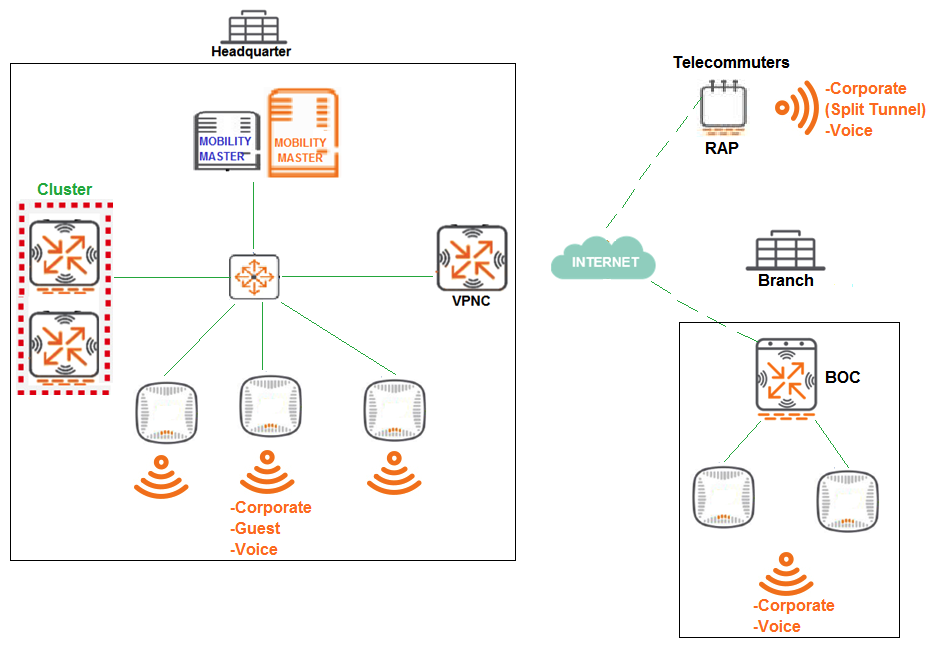 A company has a multiple Arua implementation with three different locations named Headquarter, Branch, and Telecommuters. The network design includes the following: Headquarter APs terminate at the Mobility Controller (MC) cluster and propagate Corporate, Guest, and Voice SSIDs Branch APs terminate at the Branch Office Controller (BOC) and propagate Corporate and Voice SSIDs BOC reaches the Mobility Master (MM) through a VPNC. Telecommuter RAPs terminate at VPNC and propagate Corporate and Voice SSIDs. The Corporate SSID on the RAPs is split-tunnel, all other SSIDs are tunnel. The network design requires minimal AP group and VAP configuration effor, while preventing unnecessary VAP propagation to lower hierarchy levels. Following Aruba node hierarchy desing recommendations, which group hierarchy design helps meet these requirements?
A company has a multiple Arua implementation with three different locations named Headquarter, Branch, and Telecommuters. The network design includes the following: Headquarter APs terminate at the Mobility Controller (MC) cluster and propagate Corporate, Guest, and Voice SSIDs Branch APs terminate at the Branch Office Controller (BOC) and propagate Corporate and Voice SSIDs BOC reaches the Mobility Master (MM) through a VPNC. Telecommuter RAPs terminate at VPNC and propagate Corporate and Voice SSIDs. The Corporate SSID on the RAPs is split-tunnel, all other SSIDs are tunnel. The network design requires minimal AP group and VAP configuration effor, while preventing unnecessary VAP propagation to lower hierarchy levels. Following Aruba node hierarchy desing recommendations, which group hierarchy design helps meet these requirements?
A) /md /md/Corp1/ /md/Corp1/Offices /md/Corp1/Offices/Headquarter /md/Corp1/Offices/Branch /md/Corp1/Telecommuters /mm /mm/mynode
B) /md/Headquarter /md/Branch /md/Telecommuters
C) /md/Locations /md/Locations/Headquarter /md/Locations/Branch /md/Locations/Telecommuters
D) /md/Location1/ /md/Location1/Branch /mdLocation1/Offices /md/Location1/Offices/Headquarter /md/Location1/Telecommuters
Correct Answer

verified
Correct Answer
verified
Multiple Choice
A foreign exchange broker in a shared office space uses an Aruba Mobility Master (MM) -Mobility Controller (MC) architecture along with ClearPass and AirWave. The corporate network is FXBroker121, but users report that they cannot access the FXBroker111 SSID. The team suspects that a rogue AP is in place and a malicious user tried to disguise the WLAN name. How can the organization's network administrator identify and locate the potential rogue AP?
A) Create an AirWave RAPIDS rule with a Suspected Rogue classification and the SSID Matches FXBroker111 condition, then access any RAPID List entry that matches the rule and click on Location.
B) Use ClearPass Event viewer and search for entries with the FXBroker111 Aruba-Essid-Name VSA attribute, then obtain the value of the Aruba-AP-Group attribute.
C) Use ClearPass Event viewer and search for entries with the FXBroker111 Aruba-Essid-Name VSA attribute, then obtain the value of the Aruba-Location-id attribute.
D) Create and AirWave RAPIDS rule with a Suspected Rogue classification and the SSID Does Not Match FXBroker121 condition, then access any RAPIDS List entry that matches the rule and click on Location.
Correct Answer

verified
Correct Answer
verified
Multiple Choice
A financial institution contacts an Aruba partner to deploy an advanced and secure Mobility Master (MM) -Mobility Controller (MC) WLAN solution in its main campus and 14 small offices/home offices (SOHOs) . Key requirements are that users at all locations, including telecommuters with VIA, should be assigned roles with policies that filter undesired traffic. Also, advanced WIPs should be enforced at the campus only. These are additional requirements for this deployment: RAPs should ship directly to their final destinations without any pre-setup and should come up with the right configuration as soon as they get Internet access. Activate should be configured with devices MACs, serial numbers, and provisioning rules that redirect them to the standalone VMC at the DMZ Users should be able to reach DNS, FTP, Web and telephone servers in the campus as well as send and receive IP telephone calls to and from the voice 10.1.50.0/24 segment. Local Internet access should be granted. Refer to the exhibit. 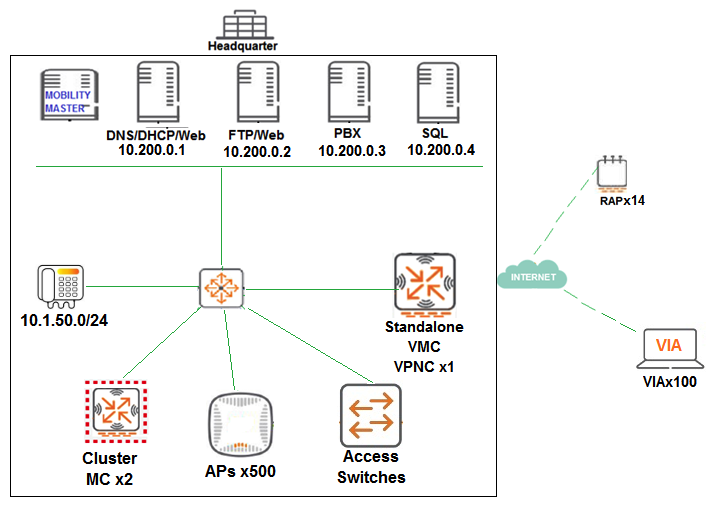 Refer to the scenario and the exhibit.
Refer to the scenario and the exhibit. 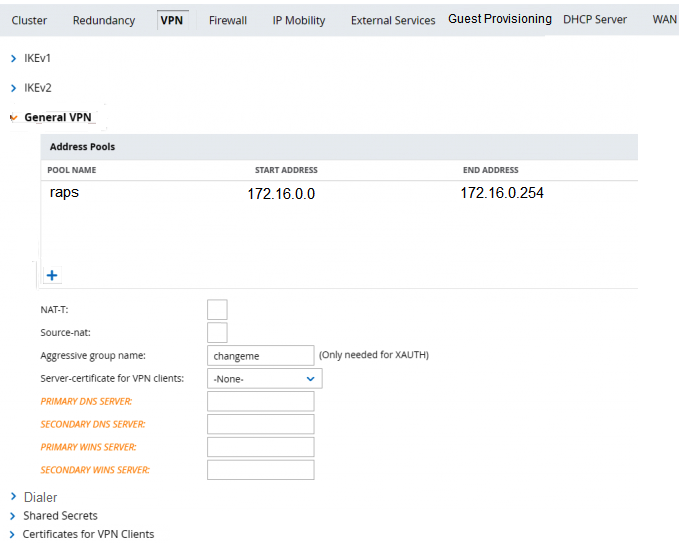 The standalone VMC will act as a VPN Concentrator of the RAPs. The network administrator configures the Standalone VMC with a pool of addresses and the SOHOs AP Group from the MM. Which additional steps must the network administrator perform to allow the RAPs to terminate their IPSec tunnels and associate to the Standalone VMC?
The standalone VMC will act as a VPN Concentrator of the RAPs. The network administrator configures the Standalone VMC with a pool of addresses and the SOHOs AP Group from the MM. Which additional steps must the network administrator perform to allow the RAPs to terminate their IPSec tunnels and associate to the Standalone VMC?
A) Add RAP MAC addresses into the RAP whitelist, and associate them with the SOHOs AP-Group.
B) Add RAP MAC addresses into the CPSec whitelist, and associate them with the SOHOs AP-Group.
C) Configure the same IP Pool at the MM group level, then create user accounts for the RAPs in the internal database.
D) Create user accounts with the sys-ap-role, and define shared secrets to associate to RAP IP addresses at the MM group level.
Correct Answer

verified
Correct Answer
verified
Multiple Choice
A company currently offers guest access with an open SSID and no authentication. A network administrator needs to integrate a web login page for visitors. To accomplish this integration, the network administrator fully deploys a guest solution with self-registration in ClearPass, and defines the Mobility Controller (MC) as a RADIUS client. Then, the network administrator defines ClearPass as a RADIUS server and adds it into a server group in the MC. Which two actions must the network administrator do next on the MC side to complete the deployment? (Select two.)
A) Associate the captive portal profile to the initial role
B) Define the web login URL and server group in a captive portal profile
C) Associate the captive portal profile to the VAP profile
D) Associate the captive portal to an AAA profile.
E) Define the web login URL in a captive portal profile and the server group in an AAA profile.
Correct Answer

verified
B,D
Correct Answer
verified
Multiple Choice
Refer to the exhibits. Exhibit 1 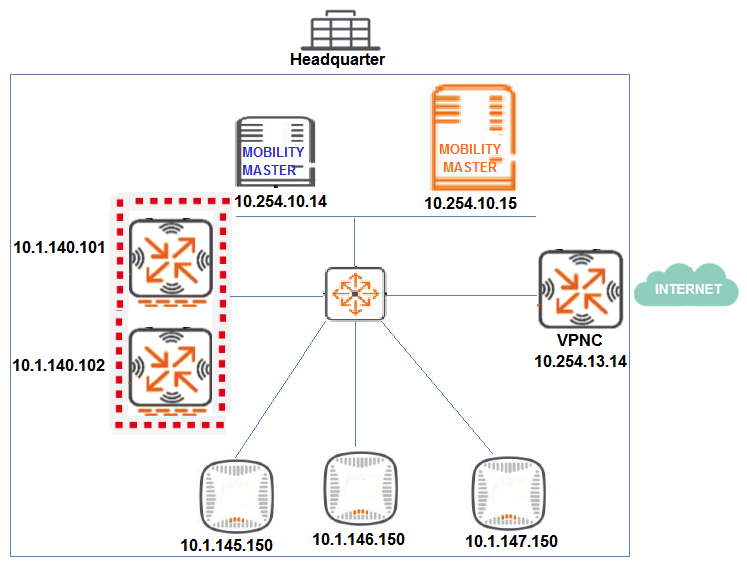 Exhibit 2
Exhibit 2 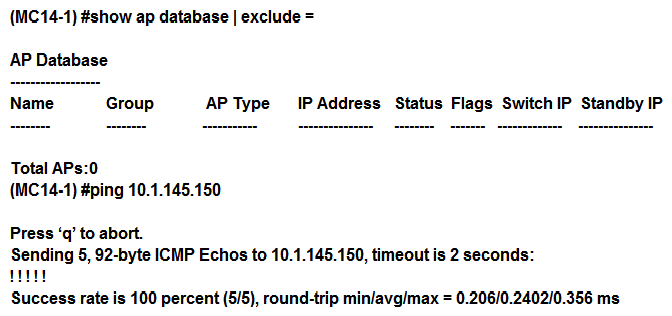 Exhibit 3
Exhibit 3 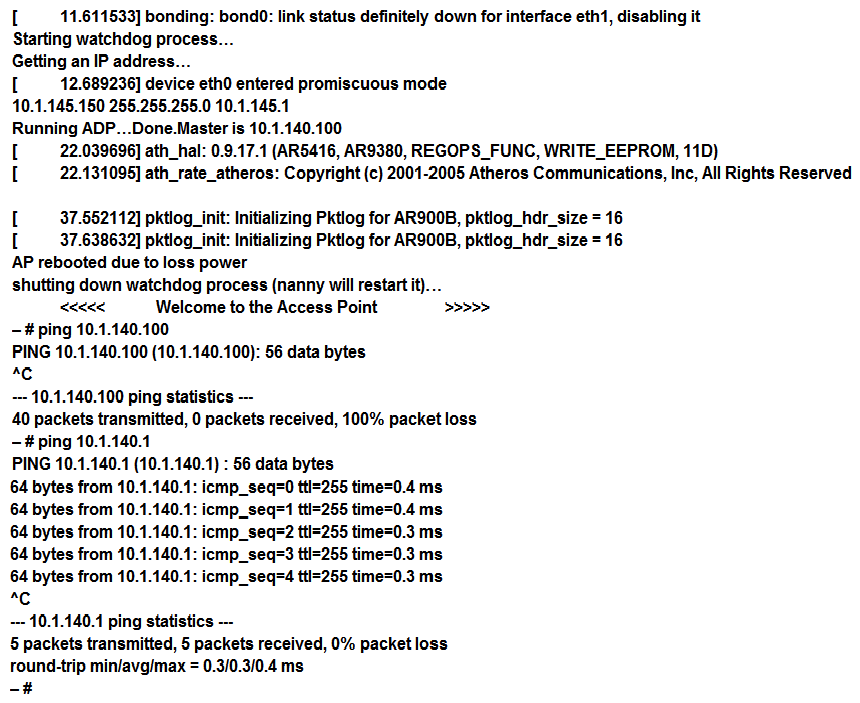 A network engineer deploys a Master Controller (MC) cluster at Headquarter to offer high levels of redundancy, and prepares the wired side of the network. This preparation includes the VLAN, DHCP Settings, and unicast routing services that APs require to reach the cluster. The network engineer waits for 20 minutes after connecting the APs and sees that no SSIDs are advertised. The network engineer logs into one of the MCs and one of the AP's consoles to obtain the outputs shown in the exhibits. What can the network engineer do to fix the APs discovery process, to ensure the best scalability even if one MC fails?
A network engineer deploys a Master Controller (MC) cluster at Headquarter to offer high levels of redundancy, and prepares the wired side of the network. This preparation includes the VLAN, DHCP Settings, and unicast routing services that APs require to reach the cluster. The network engineer waits for 20 minutes after connecting the APs and sees that no SSIDs are advertised. The network engineer logs into one of the MCs and one of the AP's consoles to obtain the outputs shown in the exhibits. What can the network engineer do to fix the APs discovery process, to ensure the best scalability even if one MC fails?
A) Reprovision the APs with a different Master IP.
B) Modify the IP address in one of the MCs.
C) Modify option 43 in the DHCP pool.
D) Create a VRRP instance in the MCs.
Correct Answer

verified
Correct Answer
verified
Multiple Choice
Users run encrypted Skype for Business traffic with no WMM support over an Aruba Mobility Master (MM) -Mobility Controller (MC) based network. When voice, video, and application sharing traffic arrive at the wired side of the network, all the flows look alike due the lack of L2 or L3 markings. How can the network administrator identify these flows and mark QoS accordingly?
A) Confirm the MC is the Openflow controller of the MMs and Openflow is enabled in VAP and the firewall roles. Then enable WMM in a VAP profile.
B) Confirm the MM is the Openflow controller of the MCs and Openflow is enabled in VAP and the firewall roles. Then integrate the MM with the Skype4Business SDN API, and enable the Skype4Business ALG in the UCC Profiles.
C) Confirm the MC is the OpenFlow controller of the MMs and Openflow is enabled in VAP and the firewall roles. Then enable the Skype4Business ALG in the UCC profiles.
D) Use a media firewall policy that match these three flows, and use permit and TOS actions with 56, 40, and 34 values for voice, video, and application sharing, respectively. Then enable the Skype4Business ALG in the UCC profiles.
Correct Answer

verified
Correct Answer
verified
Multiple Choice
An organization wants to deploy a WLAN infrastructure that provides connectivity to these client categories: Employees Contractors Guest users Corporate IoT legacy devices that support no authentication or encryption Employees and contractors must authenticate with company credentials and get network access based on AD group membership. Guest users are required to authenticate with captive portal using predefined credentials. Only employees will run L2 encryption. Which implementation plan fulfills the requirements while maximizing the channel usage?
A) Create VAP1 to run WPA2-AES and 802.1x authentication, VAP2 to run opensystem encryption with MAC authentication, and VAP3 to run opensystem with captive portal.
B) Create VAP1 to run WPA2-AES and 802.1x authentication, VAP2 to run opensystem encryption with MAC authentication, and VAP3 to run opensystem with captive portal and L2 fail through.
C) Create a single VAP to run WPA2-AES and 802.1x authentication, MAC authentication L2 fail through, captive portal, and VIA support.
D) Create VAP1 to run WPA2-AES and 802.1x authentication, and VAP2 to run opensystem encryption with MAC authentication and captive portal.
Correct Answer

verified
Correct Answer
verified
Multiple Choice
A network administrator assists with the migration of a WLAN from a third-party vendor to Aruba in different locations throughout the country. In order to manage the solution from a central point, the network administrator decides to deploy redundant Mobility Masters (MMs) in a datacenter that are reachable through the Internet. Since not all locations own public IP addresses, the security team is not able to configure strict firewall policies at the datacenter without disrupting some MM to Mobility Controller (MC) communications. They are also concerned about exposing the MMs to unauthorized inbound connection attempts. What should the network administrator do to ensure the solution is functional and secure?
A) Deploy an MC at the datacenter as a VPN concentrator.
B) Block all ports to the MMs except UDP 500 and 4500.
C) Install a PEFV license, and configure firewall policies that protect the MM.
D) Block all inbound connections, and instruct the MM to initiate the connection to the MCs.
Correct Answer

verified
Correct Answer
verified
Multiple Choice
Refer to the exhibit. 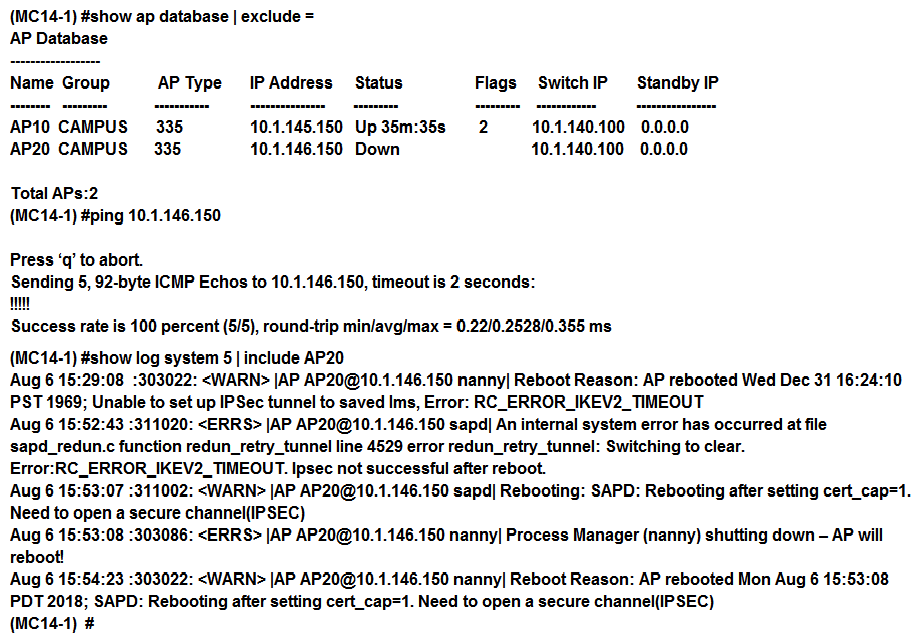 A network administrator deploys a Mobility Master (MM) -Mobility Controller (MC) solution in the headquarters. The network administrator prepares the wired side of the network with the proper VLAN, DHCP settings, and routing services to ensure that APs can reach the MCs. The network administrator connects two APs in different IP segments and waits for 20 minutes, but SSIDs are advertised in one of the APs only. The engineer logs into the MC console and sees the output shown in the exhibit. What is the reason that the AP20 is not broadcasting SSIDs?
A network administrator deploys a Mobility Master (MM) -Mobility Controller (MC) solution in the headquarters. The network administrator prepares the wired side of the network with the proper VLAN, DHCP settings, and routing services to ensure that APs can reach the MCs. The network administrator connects two APs in different IP segments and waits for 20 minutes, but SSIDs are advertised in one of the APs only. The engineer logs into the MC console and sees the output shown in the exhibit. What is the reason that the AP20 is not broadcasting SSIDs?
A) IPSec traffic is being blocked.
B) IKE traffic is being dropped.
C) PAPI traffic is being blocked.
D) GRE traffic is being blocked.
Correct Answer

verified
Correct Answer
verified
Multiple Choice
Refer to the exhibit.  A network administrator adds a Mobility Controller (MC) in the /mm level and notices that the device does not show up in the managed networks hierarchy. The network administrator accesses the CLI, executes the show switches command, and obtains the output shown in the exhibit. What is the reason that the MC does not appear as a managed device in the hierarchy?
A network administrator adds a Mobility Controller (MC) in the /mm level and notices that the device does not show up in the managed networks hierarchy. The network administrator accesses the CLI, executes the show switches command, and obtains the output shown in the exhibit. What is the reason that the MC does not appear as a managed device in the hierarchy?
A) The network administrator added the device using the wrong Pre=shared Key (PSK) .
B) The digital certificate of the MC is not trusted by the MM.
C) The IP address of the MC does not match the one that was defined in the MM.
D) The network administrator has not moved the device into a group yet.
Correct Answer

verified
Correct Answer
verified
Multiple Choice
Refer to the exhibits. Exhibit 1 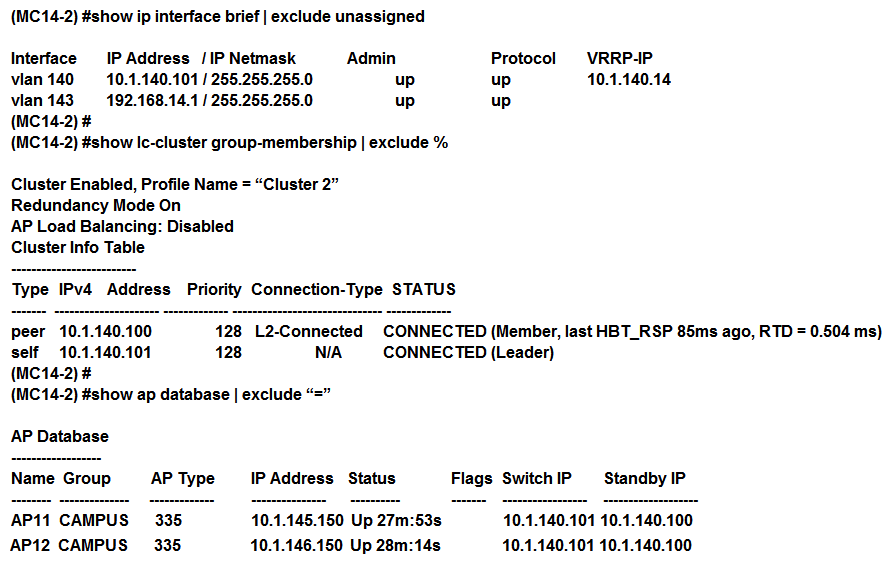 Exhibit 2
Exhibit 2 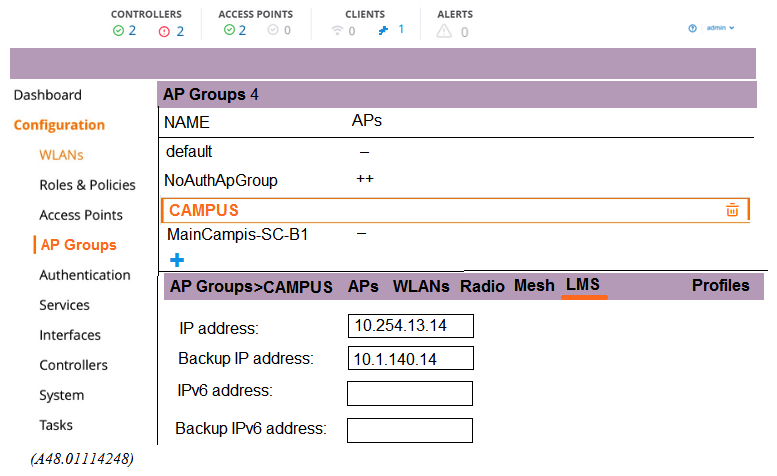 A network administrator deploys a test environment with two Mobility Masters (MMs) , two two-member Mobility Controller (MC) clusters, and two CAPs, with the intention of testing several ArubaOS features, Cluster members run VRRP for AP boot redundancy. Based on the information shown in the exhibits, what is the current status of the APs?
A network administrator deploys a test environment with two Mobility Masters (MMs) , two two-member Mobility Controller (MC) clusters, and two CAPs, with the intention of testing several ArubaOS features, Cluster members run VRRP for AP boot redundancy. Based on the information shown in the exhibits, what is the current status of the APs?
A) APs are currently communicating with LMS IP, and 10.1.140.100 is S-AAC.
B) APs are currently communicating with BLMS IP, and 10.1.140.101 is A-AAC.
C) APs are currently communicating with BLMS IP, and 10.1.140.101 is S-AAC.
D) APs are currently communicating with BLMS IP, and 10.1.140.100 is A-AAC.
Correct Answer

verified
Correct Answer
verified
Multiple Choice
A software development company has 700 employees who work from home. The company also has small offices located in different cities throughout the world. During working hours, they use RAPs to connect to a datacenter to upload software code as well as interact with databases. In the past two months, brief failures have occurred in the 7240XM Mobility Controller (MC) that runs ArubaOS 8.3 and terminates the RAPs. These RAPs disconnect, affecting the users connected to the RAPs. This also causes problems with code uploads and database synchronizations. Therefore, the company decides to add a second 7240XM controller for redundancy. How should the network administrator deploy both controllers in order to provide redundancy while preventing failover events from disconnecting users?
A) Connect both controllers with common VLANs, and create an L2-connected cluster using public addresses in the internet VLAN.
B) Connect both controllers with common VLANs, and create an HA fast failover group with public addresses in the internet VLAN.
C) Connect both controllers with different VLANs, and create an L2-connected cluster using private addresses in the internet VLAN.
D) Connect both controllers with common VLANs, and configure LMS/BLMS values equal to public addresses in the internet VLAN.
Correct Answer

verified
Correct Answer
verified
Multiple Choice
A network administrator deploys APs with radios in Air Monitor mode and detects several APs and SSIDs that belong to stores next door. The Mobility Master (MM) classifies the APs and SSIDs as potential rogues. The network administrator wants to prevent the Air Monitor from applying countermeasures against these APs. How can the network administrator accomplish this?
A) Select the BSSID and click reclassify, then select neighbor.
B) Run the Define WIP Policy task, and define the BSSIDs of the neighboring APs as interfering.
C) Select the BSSID and click reclassify, then select interfering.
D) Run the Define WIP Policy task, and define the BSSIDs of the neighboring APs as Authorized.
Correct Answer

verified
Correct Answer
verified
Multiple Choice
Refer to the exhibit. 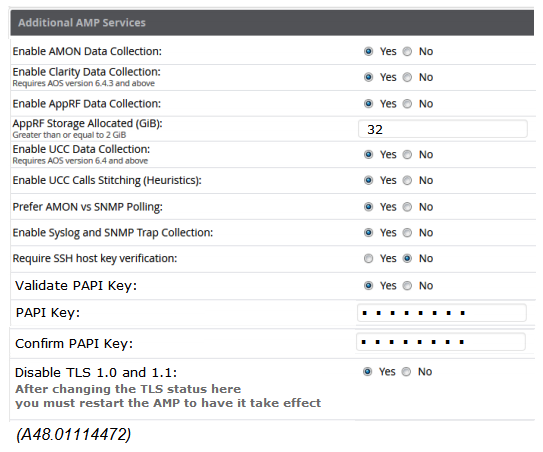 A network administrator configures a Mobility Master (MM) -Mobility Controller (MC) solution and integrates it with AirWave. The network administrator configures the SNMP and terminal credentials in the MM and MC, and then monitors the mobility devices from AirWave, including Clarity for user association and basic network services verification. However, AirWave does not display any UCC data that is available in the MM dashboard. Based on the information shown in the exhibit, which configuration step should the network administrator do next in the MM to complete the integration with AirWave?
A network administrator configures a Mobility Master (MM) -Mobility Controller (MC) solution and integrates it with AirWave. The network administrator configures the SNMP and terminal credentials in the MM and MC, and then monitors the mobility devices from AirWave, including Clarity for user association and basic network services verification. However, AirWave does not display any UCC data that is available in the MM dashboard. Based on the information shown in the exhibit, which configuration step should the network administrator do next in the MM to complete the integration with AirWave?
A) Define AirWave as a management server in the MM.
B) Enable the inline network services statistics in the AMP profile.
C) Enable UCC monitoring in the AMP profile.
D) Verify the papi-security key in the AMP profile.
Correct Answer

verified
Correct Answer
verified
Showing 1 - 20 of 54
Related Exams